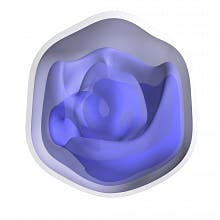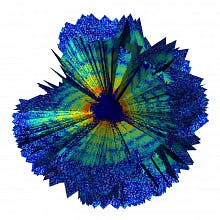X-ray laser reveals details of Mimivirus in 3D
For the first time, researchers at Uppsala University (Sweden) have produced a 3D image revealing part of the inner structure of an intact, infectious virus, using a unique x-ray laser at the Department of Energy's SLAC National Accelerator Laboratory (Menlo Park, CA). The virus, called Mimivirus, is in a curious class of "giant viruses" discovered just over a decade ago.
Related: X-ray laser images Megavirus in high-resolution 3D
The experiment at SLAC's Linac Coherent Light Source (LCLS), a DOE Office of Science User Facility, establishes a new technique for reconstructing the 3D structure of many types of biological samples from a series of x-ray laser snapshots.
Mimivirus is so big—its volume is thousands of times larger than the smallest viruses and even larger than some bacteria—that it was misclassified as a bacterium until 2003. Subsequent discoveries have found other giant viruses, some of which are even larger. Mimivirus is also genetically complex, with nearly 1000 major genes compared to only a handful in the HIV virus.
In the LCLS experiment, researchers sprayed a gas-propelled aerosol containing active Mimivirus samples in a thin stream into the x-ray laser beam, which scattered off the viruses and produced light patterns on a detector that were recorded as diffraction images.
The researchers, led by Tomas Ekeberg, a biophysicist at Uppsala University, customized sophisticated analysis software developed at Cornell University (Ithaca, NY) to compile hundreds of individual images from separate virus particles into a single 3D portrait showing the general shape and inner features of Mimivirus. Each image captured a projection of a separate virus particle at a random orientation, so the collection of images of viruses in different orientations provided a more complete, 3D view.
While the technique used at LCLS did not provide high-resolution details of the internal virus structure, it did confirm that its contents are lopsided, with an area that appears more densely concentrated.
This same general feature had also been seen before using an electron-based imaging technique with frozen samples, and LCLS allows studies of viruses and other biological samples in a more natural, intact state. Researchers said that LCLS shows promise for achieving sharper images that reveal more inner details in the future because of the uniquely intense, penetrating power of its x-rays.
The same technique was recently used to study bacterial cell structures. LCLS managers have launched an initiative with the scientific community to improve techniques for imaging intact, biological particles that are difficult to study.
Janos Hajdu, a professor of biophysics at Uppsala University and a pioneer in biological particle imaging with x-ray lasers, said the research team plans to apply the 3D imaging technique to other types of samples, such as large, single proteins, and to improve the image quality.
Full details of the work appear in the journal Physical Review Letters; for more information, please visit http://dx.doi.org/10.1103/physrevlett.114.098102.
-----
Follow us on Twitter, 'like' us on Facebook, connect with us on Google+, and join our group on LinkedIn


